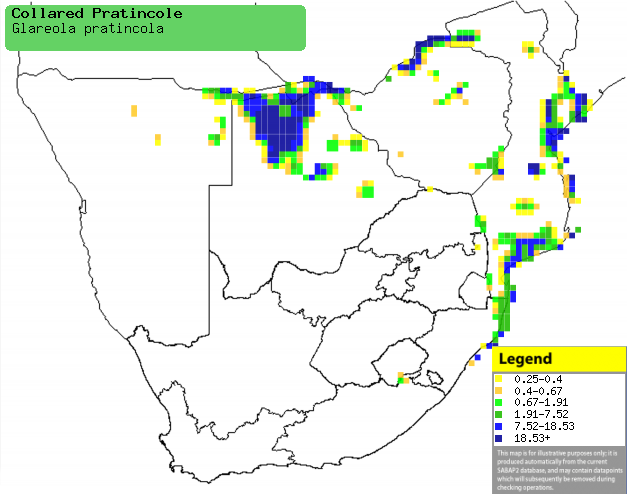|
Glareola pratincola (Collared
pratincole, Red-winged pratincole)
Rooivlerksprinkaanvoël [Afrikaans]; iWamba [Zulu];
Vorkstaartplevier [Dutch]; Glaréole à collier [French]; Brachschwalbe
[German]; Perdiz-do-mar-d'asa-vermelha [Portuguese]
Life
> Eukaryotes >
Opisthokonta
> Metazoa (animals) >
Bilateria >
Deuterostomia > Chordata >
Craniata > Vertebrata (vertebrates) > Gnathostomata (jawed
vertebrates) > Teleostomi (teleost fish) > Osteichthyes (bony fish) > Class:
Sarcopterygii (lobe-finned
fish) > Stegocephalia (terrestrial
vertebrates) > Tetrapoda
(four-legged vertebrates) > Reptiliomorpha > Amniota >
Reptilia (reptiles) >
Romeriida > Diapsida > Archosauromorpha > Archosauria >
Dinosauria
(dinosaurs) > Saurischia > Theropoda (bipedal predatory dinosaurs) >
Coelurosauria > Maniraptora > Aves
(birds) >
Order: Charadriiformes > Family: Glareolidae
For information about this species, see
birdinfo.co.za.
Distribution and habitat
Mainly breeds discontinuously from the Iberian peninsula
and Morocco east to Russia, also occupying much of sub-Saharan Africa, largely
excluding the lowland forest of West Africa. In southern Africa it is locally common in northern
Botswana, the Caprivi Strip (Namibia), northern Zimbabwe, central and southern
Mozambique and eastern South Africa. It generally prefers sandbanks, mudflats,
grassy flood plains, ploughed fields, burnt grass and overgrazed veld,
especially if adjacent to coastal lakes, pans, large rivers, estuaries and dams.
|
 |
|
Distribution of Collared pratincole in southern Africa,
based on statistical smoothing of the records from first SA Bird Atlas
Project (©
Animal Demography unit, University of
Cape Town; smoothing by Birgit Erni and Francesca Little). Colours range
from dark blue (most common) through to yellow (least common).
See here for the latest distribution
from the SABAP2. |
Movements and migrations
Mainly migratory, staying to breed in southern
Africa from about July-February, although along the Zambezi River it
is present from April-November.
Food
It mainly eats insects, doing most of its foraging in the
evening or on moonlight nights, catching prey aerially in a manner similar to
swallows, or pouncing on small invertebrates on the ground. The following food items have been recorded
in its diet:
Breeding
- Monogamous and usually loosely colonial, although it may nest solitarily,
and cooperative polyandry is rarely recorded (three adults sharing
incubation and chick-rearing duties).
- The nest (see images below) is a shallow depression or hoofprint in the
ground, either in soil, gravel or dead vegetation, typically near water on
open and flat expanses of mud.
- Egg-laying season is from June-December, peaking from October-December.
- It lays 1-2 eggs, which are incubated by both sexes for about 17-18
days, often wetting their bellies on hot days to cool the eggs.
- The chicks leave the nest within about 2-3 days of hatching and are
cared for by both parents, fledging at about 25-30 days old.
Threats
Not threatened globally, but Rare and
Near-threatened in South Africa, as its range in the country has contracted
due to urbanisation and development. However in Zimbabwe and eastern Botswana it
has benefited from the construction of large dams which have widened its
breeding range.
References
-
Hockey PAR, Dean WRJ and Ryan PG 2005. Roberts
- Birds of southern Africa, VIIth ed. The Trustees of the John Voelcker
Bird Book Fund, Cape Town.
|
